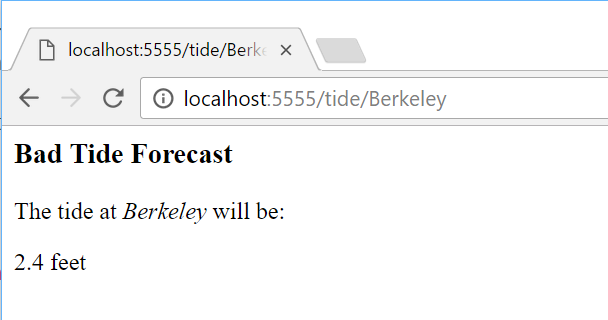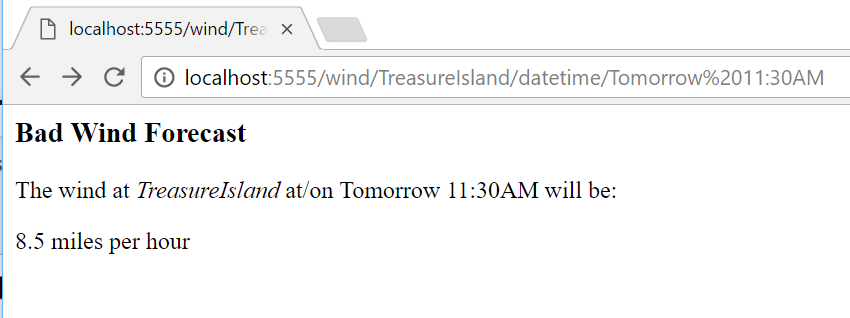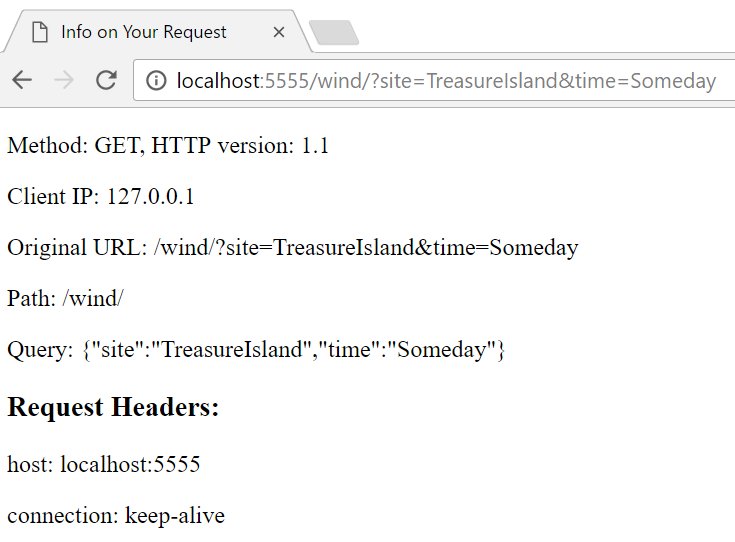Web Frameworks and Express
Dr. Greg Bernstein
Updated October 18th, 2021
Web Server Frameworks
Learning Objectives
- Understand the basic services provided by a “web framework” and create servers with Express.js
- Understand and use “routing” in the context of Express.js
- Understand how to obtain HTTP requests, and set HTTP responses
- Enhance and extend Express.js functionality with middleware
Web Server Minimal Features
Basic HTTP and URL Processing
Map URL and HTTP Method to some type of action, typically a function call. This process is sometimes called routing.
Process HTTP request messages prior to delivering to the action mentioned above. This could be as simple as separating the path portion of a URL or more complicated body processing.
Create and augment HTTP response message under the control of the action above to provide a response to the client.
Web Server Advanced/Optional Features
Database connectivity, also known as Object Relational Mapping (ORM) for connecting to databases of various types.
Content Administration, administrative UI, deployment, etc…
Site (outline) generators, RSS Feeds, REST API generators, etc…
“Full Featured” Frameworks
“Micro” Frameworks
- Basic processing only in the box
- Extended with plugins or middleware
- Much smaller learning curve if you understand basics of HTTP and URLs
- Examples: Python’s Flask, JavaScript’s Express.js
Express for Class
We will use the Express.js in this class
Smaller learning curve that reinforces what we are learning about HTTP, URLs, etc…
Express.js is extremely popular (10 Million downloads a week on NPM) and well tested from a bug and security point of view.
Easy to start with, scales to large sites, Node.js deployments supported by many types of hosting services: Heroku, Google App Engine, AWS, Microsoft Azure, etc…
Express.js
References and Samples
- Archive of examples: ExpressExamples.zip
- Express.js Web Site
- Express.js API Documentation v4
- Node.js HTTP Server listen
What is it?
Express is a minimal and flexible Node.js web application framework that provides a robust set of features for web and mobile applications.
Installation
npm install express --save
Simplest Example Possible
Put this in a file called hello.mjs
import express from 'express';
const app = express();
app.get('/', function (req, res) {
res.send('Hello Website Development!');
});
app.listen(3000, function () {
console.log('Example app listening on port 3000!');
});Run and Visit
- Running the server:
node hello.mjs - Visiting the site
- In your browser type the URL:
http://localhost:3000/
- In your browser type the URL:
- Hopefully you got the text
Hello Website Development!in your browser window
localhost?
localhostis a defacto standard name used to refer to one of your computers local loopback addresses. It is usually set to127.0.0.1in ahostsfile buried somewhere on your operating system.You actually have a whole range of loopback addresses you can use: 127.0.0.1 to 127.255.255.254. Loopback addresses are local to your machine!
See localhost and loopback addresses, but do not confused loopback with private IP addresses.
Listening on other ports and addresses
// All sorts of express related code
port = 5555; // Or anything you'd like
host = '127.0.0.2'; // Any loopback address
app.listen(port, host, function () {
console.log(`Example app listening on IPv4: ${host}:${port}`);
});Hands-on Multiple Servers
- Make copies of the
hello.mjsfile, i.e.,hello2.mjs,hello3.mjs - Change the messages they send a bit
- Have them listen on different (port, host) combinations
- Start each in its own command window
Line by Line I
import express from 'express';:- Imports Express
var app = express();:- Creates an express app
Line by Line II
Registers a callback function on the / path to respond to HTTP GET requests:
app.get('/', function (req, res) {
res.send('Hello Website Development!');
});Line by Line III
Starts the server listening on the given port and host/IP address:
port = 5555; // Or anything you'd like
host = '127.0.0.2'; // Any loopback address
app.listen(port, host, function () {
console.log(`Example app listening on IPv4: ${host}:${port}`);
});A Slightly More Complicated Example
HelloCount.mjs
import express from 'express';
const app = express();
let count = 0;
app.get('/', function (req, res) {
count++;
res.send(`<body><p>Hello CS351!</p>
<p>This is from the helloCount.mjs Application.</p>
<p>This page has been visited <strong>${count} times.</strong></p></body>`);
});
const host = '127.0.0.2';
const port = '5555';
app.listen(port, host, function () {
console.log(`Example app listening on IPv4: ${host}:${port}`);
});Key Express Concepts
Routes: maps an HTTP method and request URL path to a function to handle the client request
Request and Response Objects: We do any work we need with HTTP request and response messages via the “req”, and “res” objects passed to our route handler functions or middleware.
Middleware: 3rd party or self written to provide additional capabilities to express by modifying Request and Response objects.
Express Routing
Routing References
Routing?
Application layer routing at the server, not IP routing.
Routing refers to determining how an application responds to a client request to a particular endpoint, which is a URI (or path) and a specific HTTP request method (GET, POST, and so on).
Maps HTTP method, and URL path to a function call
General Form
See app.METHOD
app.METHOD(path, callback [, callback ...])
- app is an instance of express.
- METHOD is an HTTP request method, in lowercase, e.g., (
get,put,…) - path is the path part of the HTTP request URL.
- callback is the function executed when the route is matched. We can have more than one (see middleware slides.)
Simple Example
From simpleRoute.mjs
import express from 'express';
const app = express();
app.get('/', function(req, res) {
res.send(`Hello!`);
});
app.get('/cs351', function(req, res) {
res.send('Web Development!');
});
app.get('/wind', function(req, res) {
console.log("Someone tried to get the wind");
res.send('Sorry Dr. B, no wind today');
});
const host = '127.0.0.1';
const port = '5555';
app.listen(port, host, function() {
console.log(`simpleRoute.mjs app listening on IPv4: ${host}:${port}`);
});Route Paths
Route paths can be strings, string patterns, or regular expressions.
- Different server frameworks vary in the types of paths they support.
Simple Match Paths
From file matchRoute.mjs (try it!):
import express from 'express';
const app = express();
app.get('/', function(req, res) {
res.send(`Hello!`);
});
app.get('/cs351/*', function(req, res) {
let path = req.path;
res.send(`Web Development!
Path = ${path}
`);
});
app.get('/wind/*', function(req, res) {
let path = req.path;
res.send(`Sorry Dr. B, no wind today
on path = ${path}`);
});
const host = '127.0.0.1';
const port = '5555';
app.listen(port, host, function() {
console.log(`matchRoute.mjs app listening on IPv4: ${host}:${port}`);
});Route Parameters
Are named URL segments that are used to capture the values specified at their position in the URL.
The captured values are populated in the
req.paramsobject, with the name of the route parameter specified in the path as their respective keys.
Route Parameter Example 1
From file parameterRoute.mjs
import express from 'express';
const app = express();
app.get('/', function(req, res) {
res.send(`Hello from Bad Wind/Tide Forecaster!`);
});
app.get('/tide/:site', function(req, res) {
let site = req.params.site;
let tide = Math.random() * 5;
res.send(`<h3>Bad Tide Forecast</h3>
<p>The tide at <em>${site}</em> will be: </p>
<p>${tide.toFixed(1)} feet</p>`);
});Route Parameter Example 2
Running it

Multiple Parameters Example
From file parameterRoute.mjs
// two parameters here site and datetime
app.get('/wind/:site/datetime/:datetime', function(req, res) {
let site = req.params.site;
let datetime = req.params.datetime;
let wind = Math.random() * 20;
res.send(`<h3>Bad Wind Forecast</h3>
<p>The wind at <em>${site}</em> at/on
${datetime} will be: </p>
<p>${wind.toFixed(1)} miles per hour</p>`);
});
const host = '127.0.0.1';
const port = '5555';
app.listen(port, host, function() {
console.log(`parameterRoute.mjs app listening on IPv4: ${host}:${port}`);
});Multiple Parameters Example
Running it…

Request Information
Express Request References
Express ‘Request’ Object adds information to Node.js’s
IncommingMessageobject.Node.js IncommingMessage object.
Some Popular Properties 1
req.path: Contains the path part of the request URL, does not include query string.req.query: An object containing a property for each query string parameter in the route. If there is no query string, it is the empty object, {}.
Some Popular Properties 2
req.body: Contains key-value pairs of data submitted in the request body. By default, it is undefined, and is populated when you use body-parsing middleware suchexpress.jsonorexpress.urlencoded.req.cookies: When usingcookie-parsermiddleware, this property is an object that contains cookies sent by the request. If the request contains no cookies, it defaults to {}.
Example Request In Depth
From file requestInfo.mjs:
import express from 'express';
const app = express();
app.get('/', function(req, res) {
res.send(info2Html(req));
});
// Simple extra route example
app.get('/wind', function(req, res) {
res.send(info2Html(req));
});
const host = '127.0.0.1';
const port = '5555';
app.listen(port, host, function() {
console.log(`requestInfo.mjs app listening on IPv4: ${host}:${port}`);
});
function info2Html(req) { // In general should use templates for this
let beginning =
`<!DOCTYPE html>
<html lang="en">
<head><meta charset="utf-8">
<title>Info on Your Request</title>
</head><body>`,
end = `</body></html>`;
let content = `<p>Method: ${req.method}, HTTP version: ${req.httpVersion}`;
content += `<p>Client IP: ${req.ip}</p>`;
content += `<p>Original URL: ${req.originalUrl}</p>`;
content += `<p>Path: ${req.path}</p>`;
content += `<p>Query: ${JSON.stringify(req.query)}</p>`;
content += `<h3>Request Headers:</h3>`;
for (let h in req.headers) {
content += `<p>${h}: ${req.headers[h]}</p>`
}
return beginning + content + end;
}Example Run

Responses
Express Response References
Response Objects
Express creates a Response object (res) for us, that we then can manipulate as needed using their Response API
Response objects are manipulated in middleware or your route handler function. You must to send a response of some type from your route handler.
Sending a response does not force a return from your route handler, use a
returnstatement for that. Symptom: server error about trying to send a response twice.
Sending a Response 1
See Express Response
res.send(body):Sends the HTTP response. Thebodyparameter can be a Buffer object, a String, an object, or an Array.res.json(myObj): Sends a JSON response. This method sends a response (with the correct content-type) that is the parameter converted to a JSON string using JSON.stringify().res.render(): Renders a view (template) and sends the rendered HTML string to the client.
Sending a Response 2
See Express Response
res.redirect(): Redirects to the URL derived from the specified path, with specified status. See Mozilla HTTP redirects for appropriate use.res.sendFile(path [, options] [, fn]): Transfers the file at the given path. Sets the Content-Type response HTTP header field based on the filename’s extension.
Response Header and Cookie Manipulation
res.append(),res.set(),res.get(): Appends (sets, gets) the specified value to the HTTP response header field. If the header is not already set, it creates the header with the specified value. The value parameter can be a string or an array.res.cookie(),res.clearCookie(): Sets (clears) cookie name to value. The value parameter may be a string or object converted to JSON. Note that a wide range of cookie options are supported.res.type(): Sets the Content-Type HTTP header to the MIME type…
Middleware with Express
Middleware References
Middleware?
- Express is a minimalistic but extensible web framework
- Like applications or other software systems that support “plugins”, Express is extended via middleware.
- Express middleware are just functions that receive and operated on the HTTP request and response objects provided by Express
- You can write your own and/or use many external packages.
Example Middleware Functionality
General website logging: minimal logging example, full featured 3rd party package express-winston
Body processing: JSON extraction express.json (built-in), Post form processing express.urlencoded (built-in), etc…
Header and Security Processing: Cookies - cookie-parser, Sessions - express-session
Serve Static Resources: built-in express.static
Static Content Middleware
Use to deliver static: HTML, CSS, JS, Images, JS Apps, etc…
To serve static files such as images, CSS files, and JavaScript files, use the
express.staticbuilt-in middleware function in Express.
Static Middleware Configuration and Behavior
app.use(express.static('dir_name'));- Puts static middleware into service
- With each client request this static middleware will check the URL’s path against the contents of the directory dir_name, if there is a match then that content is returned as the response.
- Do not include
dir_namein paths to static resources in your HTML files or templates.
Example Static Middleware Usage
From file staticAndRoutes.mjs allows access to assets in the “public” directory. Try it!
import express from 'express';
const app = express();
app.use(express.static('public')); // For static assets
app.get('/', function(req, res) {
let myObj = {
sender: "Dr. B",
to: "CS351",
message: "Hello, code the Web!"
};
res.json(myObj);
});
// Simple extra route example
app.get('/wind', function(req, res) {
res.send("I'm sorry Dr. B there is no wind right now");
});
const host = '127.0.0.1';
const port = '5556';
app.listen(port, host, function() {
console.log(`staticAndRoutes.mjs app listening on IPv4: ${host}:${port}`);
});Homemade Middleware
Can create your own middleware that does whatever you like and applies to:
All requests, good for logging, debugging, sessions,…
All requests that correspond to a specific path
Just a specific method and path
Homemade Middleware Examples
General and Path Specific Middleware from middlewareEx.mjs
/*
Code to illustrate how Express.js middleware works, both general via the
app.use(fn), and app.use(path, fn) approach.
Watch the console where you run this file for results.
*/
import express from 'express';
const app = express();
// This middleware will be applied to all requests
function logMiddleware(req, res, next) {
console.log(`log middleware called for original URL: ${req.originalUrl}, path: ${req.path}, IP: ${req.ip}`);
next();
};
app.use(logMiddleware);
function windMiddleware(req, res, next) {
console.log(`wind middleware called, path: ${req.path}`);
next();
}
app.use('/wind', windMiddleware);
app.get('/', function(req, res) {
let message = "You are at the root path, the other paths are: \n";
message += "/wind, /water";
res.send(message);
})
app.get('/wind', function(req, res) {
res.send("You are on the wind path");
});
function whateverMiddle(req, res, next) {
// Add some useless information to the request object
req.temperature = 50 + 30 * Math.random();
next();
}
app.get('/water', whateverMiddle, function(req, res) {
res.send(`You are on the water path, the temperature is ${req.temperature.toFixed(1)}`);
});
const host = '127.0.0.1';
const port = '2222';
app.listen(port, host, function() {
console.log("middleWareTest.mjs app listening on IPv4: " + host +
":" + port);
});JSON Based Servers
Why JSON Servers
Many web apps just need to send/receive data from a server rather than HTML, CSS, etc.
JSON is the most widely used format for non-binary data exchange.
Sending and Receiving JSON with Express is easy!
Sending JSON to Clients
See file basicJSONServer.mjs
import express from 'express';
const app = express();
// Just some stuff to send to client instead of a database call
let windthings = [{ name: "10m Kite", age: 4 }, { name: "7.7 Sail", age: 3 }];
app.get('/', function(req, res) {
res.json(windthings);
});Receiving JSON from Clients
We need some middleware to process the JSON body
// built in middleware is called first then our function
app.post('/addThing', express.json(), function(req, res) {
console.log(`path /addThing received: ${JSON.stringify(req.body)}`);
windthings.push(req.body);
res.json(windthings);
});
const host = '127.0.0.1';
const port = '5555';
app.listen(port, host, function() {
console.log(`Basic JSON app listening on IPv4: ${host}:${port}`);
});Testing JSON Servers
For GET paths we can point our browsers at the appropriate URL (IP address, port, path) or we can write client code.
For POST or other requests where we are sending JSON from the server we’ll use a library like node-fetch
Send JSON to Server
To test the previous server, file: postTestJSON.mjs
import fetch from 'node-fetch';
let thing = { name: "13m kite", age: 2 };
fetch('http://127.0.0.1:5555/addThing', {
method: 'post',
body: JSON.stringify(thing),
headers: { 'Content-Type': 'application/json' },
})
.then(res => res.json())
.then(json => console.log(json));